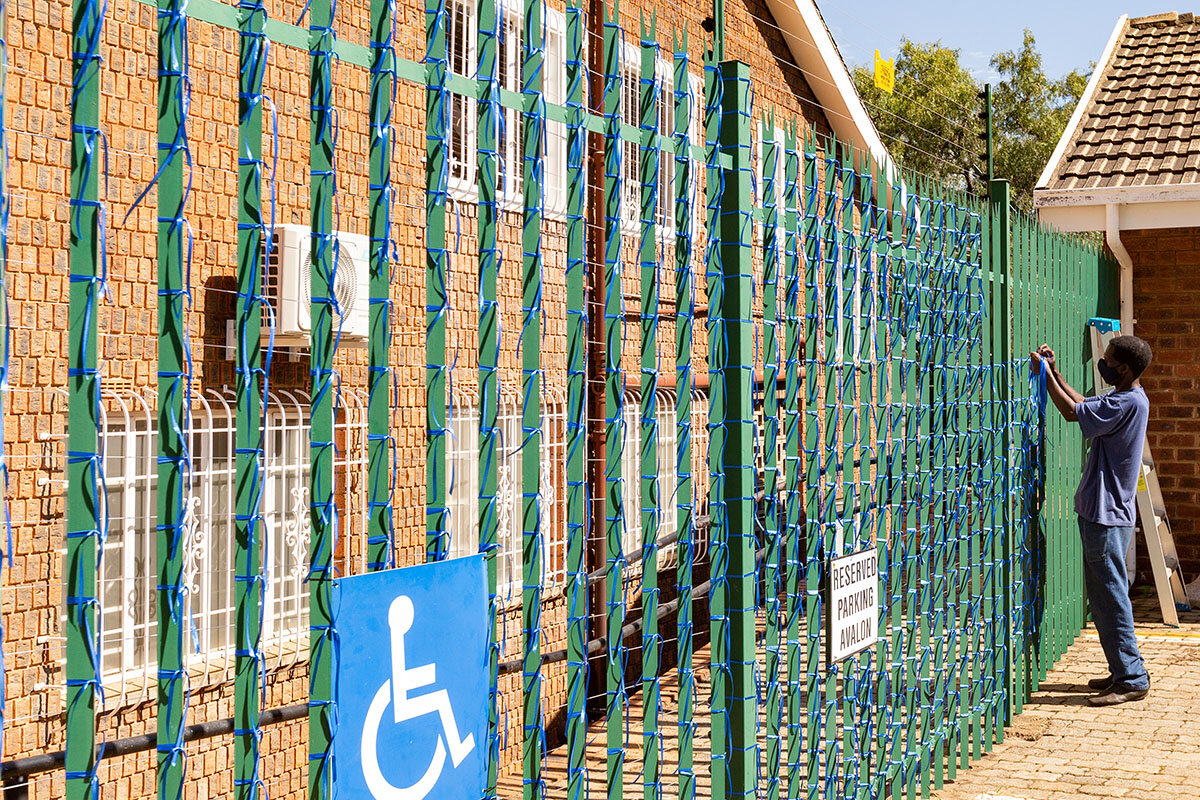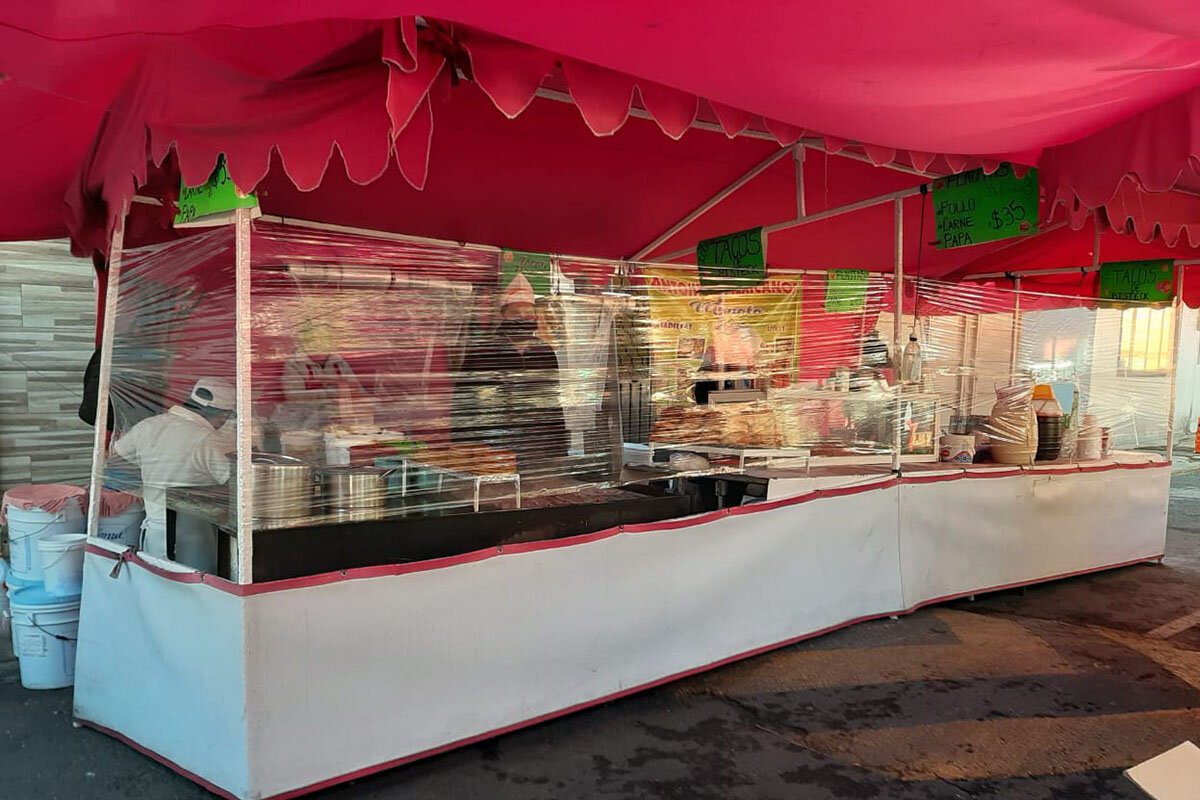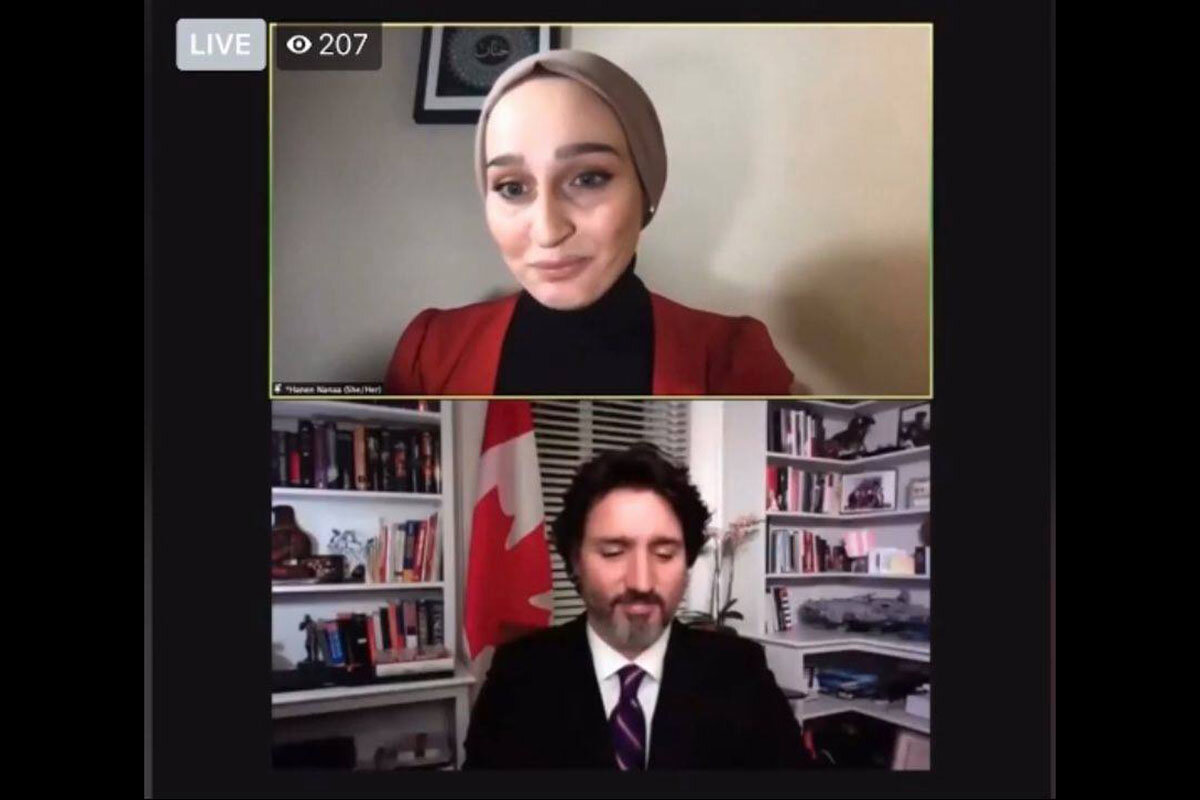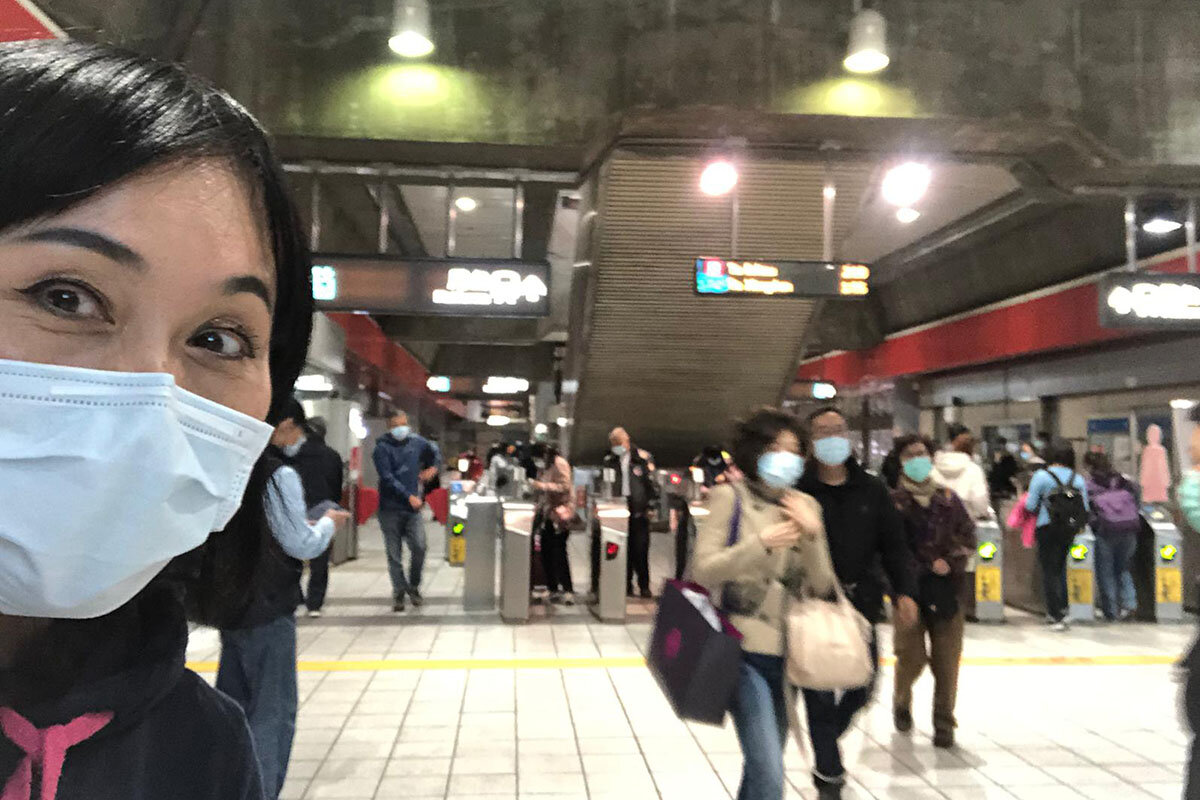How a year like no other summoned unsuspected strengths across cultures
Loading...
| Toronto, Johannesburg, Seattle, Berlin, and Mexico City
The fence around St. James Presbyterian Church, in a quiet suburb of Johannesburg, evinces a reality whose raw numbers can leave neighbors numb.��
A year into a pandemic that has taken over 50,000 lives in South Africa, church caretaker Leonard Makuya still wakes each day to hear the latest death toll on the radio, dunking bread in his milky tea as he listens.��
He and a colleague then solemnly take ribbons and tie them to the green palisade fence outside the property, a symbol of society’s growing emotional toll. Today, white and blue ribbons flutter in the wind the length of a city block.
Why We Wrote This
Different societies have different ways of fostering citizens’ resilience to shock. How has that affected the way people have grappled with the challenges of a global pandemic?
“Each of these ribbons, we keep in our minds that that’s a person,” Mr. Makuya says.
His gesture represents one individual attempt to manage the unfathomable. Since the World Health Organization officially declared the global coronavirus pandemic on March 11, 2020, 2.6 million people have died. They have left millions of others bereaved and billions more are grieving abstract loss – of their expectations and sense of predictability, their rituals, the time they would have spent in faith communities or with family, friends, classmates, or sports teams.
Darcy Harris, a scholar who studies grief at King’s University College,��Western University in London, Ontario, calls it “the loss of living our lives.”
The wave of anguish currently sweeping the globe exceeds anything the world has known for a century, says Robert Neimeyer, director of the Portland Institute for Loss and Transition, in Oregon. “All of us have had to grapple with an assault on a world of meaning that once seemed secure,” he says.
“And so,” he adds, “we’re called to … look for ways that we can draw on individual, communal, and cultural resilience to attempt to recover a fuller semblance of human life and possibility again.”
That starts at the personal level, where many of us have found reservoirs of strength, even if tinged with sadness for what has changed or gone forever. The ways in which people tap such reservoirs often reflect the cultural ethos of a place – whether they be a Mexican street food vendor hustling to survive, a Berlin artist finding a sense of purpose, a Syrian refugee in Toronto recalling worse suffering, or a middle-class real estate agent in Taiwan holding on to her faith in government guidance.����
Tacos under wraps
As the coronavirus tore across the globe, it knocked millions off their financial footing. The World Bank says that the pandemic’s effects threaten to push as many as 150 million people into extreme poverty by the end of this year.
Among the most vulnerable are “informal workers,” those working outside the regulated or protected job market. In Mexico such workers make up 60% of the labor force, and in Mexico City some have seen their incomes halved or worse, says Tania Espinosa Sánchez, who works for WIEGO, a nonprofit advocating informal workers’ rights.
Among those hit is Obdulia Montealegre Guzmán, who has served homemade blue-corn tacos at her food stand for nearly two decades, a witness to the leisurely counter meals and small talk that make up the rhythm of daily life in the Mexican capital.��
But when the simple act of sharing food in a communal space became one of the riskiest behaviors of the pandemic era, her livelihood was threatened. She made a snap decision: to encase her taco stand in plastic. She and her staff wrapped the stall��with three layers of industrial-grade plastic wrap, cutting out two tiny windows, one for taking orders and handling money and the other for delivering food.
She did shut down briefly early on in the pandemic, but she’s confident her family business will weather the storm.
That effort reflects a culture that knows how to hustle, says Héctor Castillo Berthier, a sociologist and coordinator of the youth studies unit at the National Autonomous University of Mexico. “Mexicans are used to working – almost always – with things against us,” he says. “This makes you resilient almost by default. You have to be, in order to move ahead.”
Forced to slow down, Ms. Montealegre says the financial loss has been offset by improvements in her quality of life. She says she has gotten to know her 22-year-old daughter in new ways, rekindled ties with her husband, and had the leisure, for the first time in her own life, to reflect on how she can be a better family member.
“We are all so vulnerable right now, and [this year] has really helped me understand the importance of saying ‘I make mistakes,’” she says. “I have learned to accept them and to be humble and to ask for forgiveness.”
Perseus in the playground
George Bonanno, a professor of clinical psychology who heads the��Loss, Trauma, and Emotion Lab��at Teachers College, Columbia University in New York, says trauma is misunderstood.
His research into acute events such as war or 9/11 has found that as many as two-thirds of victims showed resilient behavior patterns as they recovered. The pandemic may sometimes seem as if it will last forever, but “human beings are much more resilient than anyone assumed they were,” says Professor Bonanno, author of a forthcoming book, “The End of Trauma.” “And people adapt to just about anything.”��
Hugo Tiedje is one person whose inner strength surprised even himself. The young actor was rehearsing for��the��performance of his budding career at Berlin’s iconic Volksbühne theater when the pandemic shut down playhouses around the world. He was to play Perseus, the great Greek slayer of monsters. Instead, he felt like the one who had been put to the sword.
Mr. Tiedje had just graduated from drama school. “I felt so out of control. I felt I would be forgotten,” he recalls.
Initially, he withdrew into isolation and fear. Then, he says, he began to think, to create, and to write. He connected with a friend on Instagram to read plays, novels, and poems together. He began to reflect in his writing. “I learned to be with myself more,” he says.
He also connected with a group of Berlin-based artists who’d begun a careful study of Germany’s COVID-19 lockdown rules. Heads together, they’d brainstormed a new way to perform: Twelve artists, including a pianist, a dancer, a singer, a French horn player, and an actor, each played a role in his or her own room in an old Berlin brewery, as socially distanced audiences of 10 swept through for mini-performances at five-minute intervals.
“The image of half-filled concert halls was depressing because all that does is call attention to what you’re missing. It’s only a lesser version of the full thing,” says Chris Lloyd, a concert pianist and co-founder of the 1781 Collective, which curated the performance. “We looked at our limitations and created something that fits our new reality, something more meaningful.”��
The 1781 Collective takes its name from the year Mozart shed his job as a court-employed organist, and set off on a topsy-turvy career as a freelancer. Born as a celebration of independent talent, the collective would not have survived anywhere but in a city like Berlin, say its members.
“Berlin is a playground, with the open-mindedness here. Artists are more willing to share their creativity,” says Mr. Lloyd. Just as importantly, the German government softened the lockdown’s impact somewhat by offering some financial aid to students, artists, and freelance performers.
For Mr. Tiedje, the state’s support and Berlin’s creative atmosphere were a lifeline. “I could only stay calm during the pandemic because I had this help,” he says. “If I hadn’t had this, I would have been scared all the time.”��
“I am so much more resilient now,” Mr. Tiedje adds. “When the next crisis comes, I will be able to find my peace so much faster.”
It could be worse
Most people, when their world is turned upside down, feel a sense of loss.��But others, for whom the pandemic is not their first existential challenge,��can draw on their memories of much tougher times they’ve lived through.
Hanen Nanaa was a Syrian refugee when she arrived in Toronto just over five years ago with her five siblings, parents, and grandmother – the only one who spoke English.
The pandemic has been hard on the whole family, but especially for Ms. Nanaa, who leads a packed academic, professional, and volunteer life.
Lockdown meant she had to move her university classes online, and cancel events she had worked so hard to produce with BAM, a youth arts and performance collective she had founded. She struggled with the isolation. So she took up a habit she had developed when she lived in Aleppo during the Syrian civil war, and later as a refugee in Turkey: She began to write down her thoughts.
In one essay she compared her experience of pandemic lockdown in Canada with her recollections of being shut up at home in Aleppo. “I remembered the bombing,” she says. “That there were no schools. We could not go outside; there was no water and no electricity.�� We didn’t even have technology.”
“At that moment I realized how grateful I am for this lockdown compared to the other ones,” she says. “Here we are safe.”
Indeed, she is flourishing. She has been working, organizing virtual BAM events and studying at university. In January she was asked to introduce Prime Minister Justin Trudeau in an online event marking the fifth anniversary of the mass arrival in Canada of Syrian refugees.
She framed her comparative essay and hung it on her bedroom wall.��
Do what you’re told
While pandemic resilience dwells in each person, its shape and nature will depend on social context. If a country’s public messaging is clear, for example, if its culture attaches greater importance to the collective than to the individual, or if compliance with government instructions is a driving national characteristic, such factors will influence the ways in which citizens confront the crisis, says grief expert Dr. Harris.
So in Taiwan, whose 978 confirmed COVID-19 cases and 10 deaths make it one of the world’s great pandemic success stories, real estate agent Yi-Ling Huang has kept her head down, finding strength in following government guidelines.
That’s not to say that chills didn’t run down her spine the day she found out about the new coronavirus in China, a country just 80 miles from Taiwan, where she lives in the capital Taipei. It surfaced bad memories of the deadly SARS pandemic that hit the island in 2003, when, as a young mother, she had done all she could to protect her two small children.
Last winter, she donned not only a face mask but protective eye goggles too, and carried a can of disinfectant with her – spraying it each time she stepped into her apartment building’s elevator. “We couldn’t take it easy; it’s so serious,” she says.
But Ms. Huang says the government reacted quickly, ramping up the production of masks, distributing them through pharmacies, and guaranteeing supplies for every citizen. The island nation closed itself to international travelers and instituted a strict quarantine regime with rigorous contact tracing for every case.
Taiwanese society readily complied with the measures, says Ms. Huang��(Health Minister Chen Shih-chung saw his approval ratings hit 91%), giving her a sense of security that has helped her navigate the transformations her life has undergone since last March. “This is a very tough period. Everyone needs to work together,” she says.��
In a different society she might have felt differently, says Dr. Harris in Canada. “If you’re collectively identified around independence or ... self-reliance versus if you are more oriented towards the common good, that’s going to have big input on how people will respond to pandemic measures but also how people are supported in their grief and in their losses,” she says.��
“We can’t forget”
Historians say the losses and lessons of previous pandemics have been quickly forgotten as history churns and people indulge their desire to move on. Pandemic casualties may lack the heroic script of a war memorial or the sudden drama of a terrorist attack or plane crash, but Dr. Neimeyer says collective remembrance will be key moving forward, especially as a “shadow pandemic” of grief will likely follow the acute phase.
“Being willing to use things such as the power of ritual to acknowledge these collective losses, to solemnify these losses,” he says, “is a step toward healing.”��
He notes the light ceremony at the reflecting pool in Washington, D.C., ahead of President Joe Biden’s inauguration. But even the humblest undertaking, like that of Mr. Makuya at St. James Presbyterian Church, is fortifying.
He and his colleague Silva Kossa began a year ago, choosing white ribbons to mark each death. But they risked running out of space, so in January they decided to tie blue ribbons, representing 10 deaths each. One blank gray morning in late February, just after 8 a.m., Mr. Makuya walked to the fence with eight blue ribbons; 73 people had died the day before. It was the only sign of movement on the otherwise silent tree-lined street.
“Something like this helps give people a point of closure on this trauma,” says Vuyokazi Nelly Sharpley, a sociologist at Walter Sisulu University in Mthatha, South Africa, who has studied the disruption of mourning in the time of COVID-19. “It also creates a sense of community, and helps people narrate a shared history of the trauma of the pandemic.”����
For Mr. Makuya, the ribbons have been a way to mark the passage of time when it often seemed that time had stopped altogether.��For the better part of the year, religious services have been prohibited here. Services are livestreamed from an empty chapel. Almost no one comes to the church anymore, except for funerals.
But a church needs looking after, all the same. Congregants no longer come, but the grass keeps growing. The hedges still have to be trimmed back from the electric fence. Mr. Makuya’s favorite purple lilies still bloom and die. Dust still finds its way onto window sills. It still settles over the empty pews.
Every day, behind the ribbon-covered fence, this place needs tending to, and that, in a time of deep uncertainty, is something Mr. Makuya still knows how to do.
“When people come back, I want them to find this place just as it was,” he says.��
And yet his wall of ribbons is a remembrance of all that will remain forever changed. “They’re reminding us every day,” Mr. Makuya says. “We can’t forget.”







